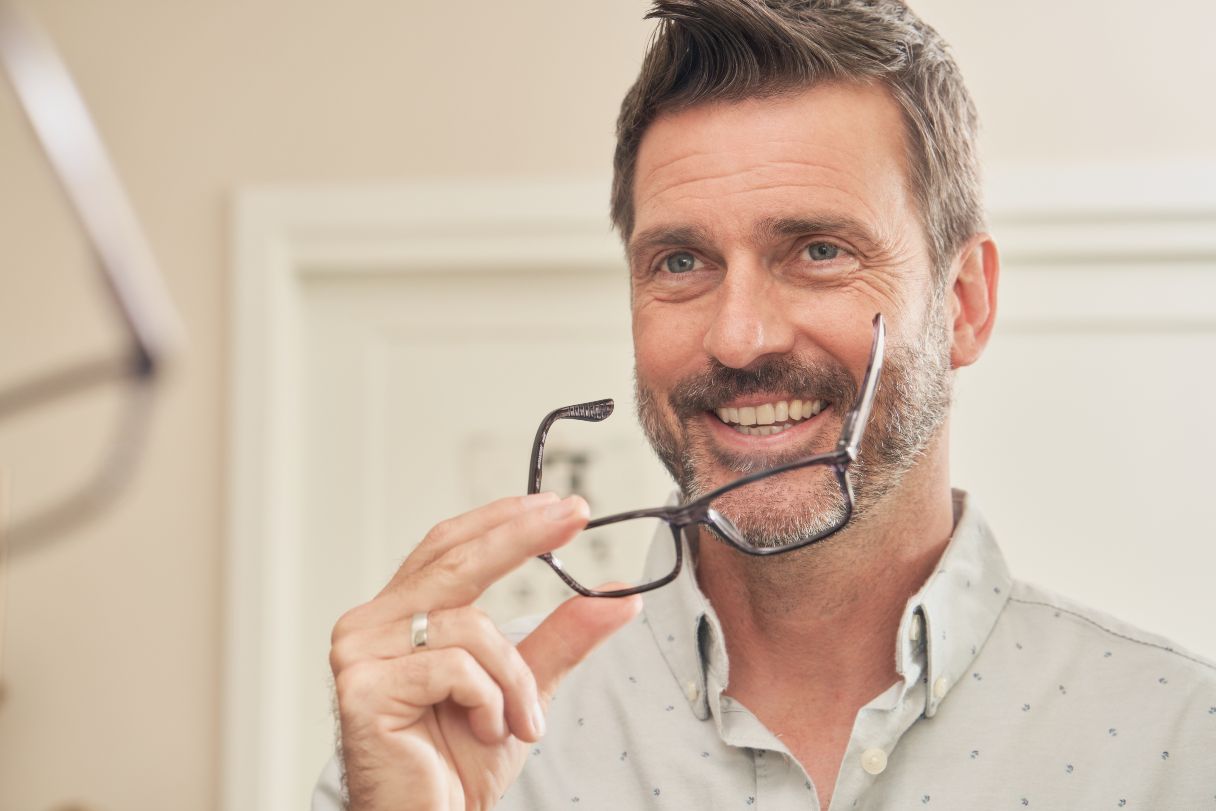Blurry lines, gray spots and other disruptions to your vision could be a sign of age-related macular degeneration. Read on to learn more about the causes and symptoms of this eye condition.
What Is Macular Degeneration?
Age-related macular degeneration (AMD) is a degenerative condition of the eyes that primarily affects older adults and leads to eventual blindness if left untreated. It’s so common that more than 50% of people over the age of 80 have the condition worldwide, and it’s considered the number one cause of blindness for people aged 65 and older.1
AMD primarily affects the backside of the eye, damaging a part of the retina known as the macula, which is high in photoreceptor cells, the very cells that make it possible for people to see with color and clarity.1
While progression can be slowed, and advances are made in research every year, there is no cure to date.1
Types of Macular Degeneration
There are two different primary types of macular degeneration:
- Dry macular degeneration
- Wet macular degeneration
Both forms include conditions of high inflammation of the retinal tissues. Both conditions also lead to similar results — loss of vision and even blindness.1
Dry AMD (Atrophic)
In the dry version of the condition, the eye begins to accumulate drusens, which are deposits of fatty lipids, proteins and other cellular debris that typically show up on eye exams as little yellow globs only visible with eye imaging tools.2 Additionally, the outer layers of the retina, known as the retinal pigment epithelium (RPE), slowly begin to thin, damaging vision.1
Wet AMD (Exudative or neovascular)
Wet AMD is more severe than dry AMD. With wet AMD, new blood vessels grow within the retinal layers in addition to drusens. This leads to fluid accumulation, possible hemorrhage and damage to the photoreceptor cells, resulting in blindness if left untreated.3
While the two types are distinct, the dry version can change to the wet version, becoming more severe and requiring immediate treatment to slow its progression.1
Causes of Macular Degeneration
Age-related macular degeneration is not caused by a single factor, but by many factors. It affects slightly more women than it does men.1 It is also more likely to occur in Caucasians than in other ethnicities.4
Other genetic factors may play a role, including gene mutations and eye pigment abnormalities.1 However, diet, body mass index, smoking and even education level are all associated with developing the condition.1 According to one study, smoking cigarettes and eating a diet low in antioxidants are the largest nongenetic risk factors.5
More recently, studies have begun to explore the possible link between light pollution at night as a factor in the wet version of AMD, but more research is needed.5
Symptoms of Macular Degeneration
Macular degeneration can present in the following ways:6
- Blurry or fuzzy vision
- Empty or gray area in the middle of your vision
- Objects appearing smaller than they actually are
- Paler than usual colors
- Straight lines appearing wavy
- Light sensitivity or changes in the way light is perceived
Eye floaters, which can appear like flecks in your field of vision, are not typically a sign of AMD.7
Stages of Macular Degeneration
AMD occurs in four stages:4
- Sub-clinical AMD. Before any abnormalities even show up on the macula, this first stage may manifest as trouble adjusting to darkness or dim light.
- Early AMD. Even in the early stages of AMD, you may not have vision loss. Only a regular eye exam can detect the drusens that are the telltale sign of it.
- Intermediate AMD. Here, you likely have some vision loss, but it could still be mild. An eye exam will look for both drusens and pigment changes in your retina.
- Late AMD. This is the stage when your vision loss is no longer subtle, and it will be classified as full AMD, advanced dry AMD or wet AMD.
Diagnosing Macular Degeneration
While there are some visual perception tests that people can do at home to self-diagnose, the best way to receive an accurate diagnosis is to visit an ophthalmologist. They’ll utilize eye imagery tools, including an optical coherence tomography (OCT) test, which projects a low-coherence laser light at the transparent part of the retina.8 This type of eye test looks for the key signs of AMD, such as fluid, drusens, inflammation and changes in your retina and other eye structures.1
Treatments for Macular Degeneration
Currently, there is no cure for AMD. Therapies and treatments can slow the progression, however, especially of wet macular degeneration.1 The main treatments for AMD are supplements and medications.
Nutritional supplements
The National Eye Institute found that a specially formulated antioxidant supplementation can slow the progression of AMD. The formulation includes the antioxidants beta-carotene, vitamin E and vitamin C, plus zinc and copper. For people predisposed to lung cancer, however, it’s better to replace the beta-carotene with lutein.9
While these supplements can range widely in cost depending on formulation and brand because they are over the counter, it’s easy to comparison shop to find the lowest prices.
Medications
Several medications are available to treat age-related macular degeneration, each with its own benefits:9
- Avastin® is a colorectal cancer drug that is used off label to treat wet AMD. Its efficacy is comparable to Lucentis.
- Eylea™ treats wet AMD by blocking the development of the blood vessels that cause vision loss. It requires fewer eye injections than Lucentis.
- Lucentis™ is a monthly injectable medication that has been shown to slow the loss of visual acuity in people with wet AMD. Its maker, Genentech, is in phase II of a clinical trial for a sustained delivery device of the drug that would offer four months of therapy each fill.
- Syfovre® treats the advanced form of dry age-related macular degeneration. The drug has been shown to reduce the atrophic lesions that form in this version of the disease.
- Vabysmo™ is another injectable drug that treats wet AMD and diabetic macular edema.
The future may be brighter for AMD treatments. Further clinical trials are in various stages for things such as gene therapy, stem cell therapy, retinal patches and other new drugs that may treat the immune response that causes atrophy in dry AMD.9
Medication Costs for AMD Treatment
While it’s difficult to determine exactly how much these drugs and treatments will cost since they can vary by insurance coverage, doctor and facility, most AMD-related exams and treatments are at least partially covered by health insurance. Many people who get AMD are aged 65 and older and thus qualify for Medicare health insurance.10
Here is a look at the average cost* for common AMD treatment options:11
| Type of AMD drug treatment | Average cost | Cost range |
|---|---|---|
| Macular degeneration treatment dry AMD (per month) | $102 | $78 to $199 |
| Macular degeneration treatment wet AMD — Avastin (per injection) | $73 | $57 to $139 |
| Macular degeneration treatment wet AMD — Eylea (per injection) | $2,034 | $1,560 to $3,861 |
| Macular degeneration treatment wet AMD — Lucentis (per injection) | $2,236 | $1,720 to $4,343 |
| Macular degeneration treatment wet AMD — Syfovre (per injection)12 | n/a | $2,316+ |
| Macular degeneration treatment wet AMD — Vabysmo(per injection)13 | n/a | $2,362+ |
Medicare covers some of the diagnostic tests and treatments of AMD, particularly a portion of the injectable drugs after you meet the Part B deductible. You may have to pay 20% of the Medicare-approved amount.10
Tips to Prevent Macular Degeneration
If you’ve already developed AMD, it’s best to consult with a healthcare professional to treat it. To prevent it, however, there are some lifestyle habits you can adopt:4
- Avoid or quit smoking.
- Eat a diet high in antioxidants.
- Get regular exercise.
- Keep your blood pressure under control.
- Maintain a healthy body weight.
- Protect your eyes from ultraviolet light.
It’s important, especially for older adults, to get regular eye exams. While AMD can’t be fully cured, early treatment can make the difference between minor vision loss and total blindness.
CareCredit Credit Card Financing for Macular Degeneration Treatment
Whether you need to pay for a visit to the ophthalmologist to diagnose AMD or seek treatment for it, the CareCredit credit card can help you pay for care where your insurance leaves off.** Use our Acceptance Locator to find a vision specialist near you that accepts CareCredit. Continue your wellness journey by downloading the CareCredit Mobile App to manage your account, find a provider on the go and easily access the Well U blog for more great articles, podcasts and videos.
In addition to vision care, you can also use your CareCredit credit card for dentistry, cosmetic, pet care, hearing, health systems, dermatology, pharmacy purchases, spa treatments and so much more within the CareCredit network. How will you invest in your health and wellness next?
Author Bio
Jordan Rosenfeld has been freelance writing for 21 years about finances, health, education and more. Her work has appeared in The Atlantic, The Billfold, Good Magazine, GoBanking Rates, Daily Worth, Quartz, Medical Economics, The New York Times, PayPal, The Washington Post and more.







